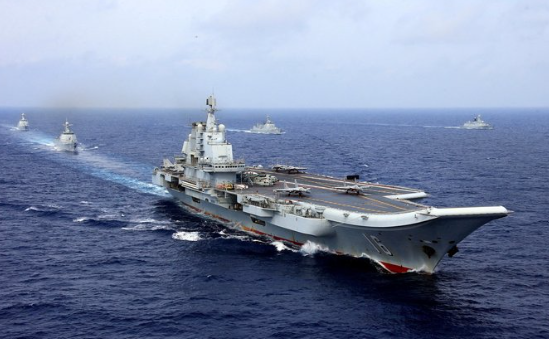A Chinese aircraft carrier cuts through the waters off Japan’s shores, not in silence, but with the steady hum of unease trailing behind it. The sea, once a boundary, now a stage— Japan watches closely as this shadow looms. It wasn’t the first time, but each movement carries its own weight. Tokyo, not one to blink in the face of encroachment, quickly raises its concerns. But there’s something different in the air— more than just protocol, it’s a kind of weariness, a call for vigilance that feels closer to the bone.
China’s aircraft carrier Liaoning enters Japan’s contiguous waters for FIRST TIME EVER! Sailed between Yonaguni & Iriomote Islands, Okinawa Prefecture. Escalating tensions in East China Sea, Japan monitoring situation closely.#China #Japan #AircraftCarrier #Liaoning #EastChinaSea pic.twitter.com/SaQyDCILKd
— Facts Prime (@factsprime35) September 18, 2024
The Liaoning— once born of Soviet steel and now flying China’s colors— didn’t sail alone. Its presence was echoed by two destroyers, an iron trio moving between Yonaguni and Iriomote. The waters here, not fully Japan’s but within its watchful eye, are still part of what they call the “contiguous zone.” It’s a grey area—where control isn’t total but presence is still felt. This wasn’t just a brief encounter; it stretched across days, moving like an old, slow current. And all this, close to the Senkaku Islands—those jagged pieces of land that Japan guards fiercely, while China, with equal fervor, names them Diaoyus. Their dispute simmers, old but not forgotten, like a low flame ready to roar at any moment.
Japan’s reaction came fast, and the words hit with precision. Deputy Chief Cabinet Secretary Hiroshi Moriya, his tone sharpened by the weight of repeated incidents, said this was “absolutely unacceptable”—no room for soft words or diplomatic cushioning. Last month, it was a Chinese reconnaissance plane skirting too close, days later a survey ship wandering into waters near Kagoshima. It is in a rhythm, setting a pattern, and Japan has grown tired of this dance movements.
They lodged their protests through the usual channels, but there’s a sense—beneath the official statements—that something more is stirring. A feeling that these repeated breaches are becoming too much. Moriya’s words carried the same insistence as before, but the urgency? Sharper. Japan is watching—closer now, more intensely—as China’s military movements grow bolder, testing boundaries, testing patience.
In a first, Chinese naval group consisting of an aircraft carrier and two other ships sailed between the Japanese islands of Yonaguni and Iriomote, located near Taiwan.
— The naval group, led by the aircraft carrier Liaoning and accompanied by two Luyang III-class missile… pic.twitter.com/EHEwJ3REAf
— Clash Report (@clashreport) September 18, 2024
And in Beijing? The response, by contrast, feels distant, almost detached. For China, this is routine. Lin Jian, a spokesperson for their Foreign Ministry was very clear about it : there’s no breach here, nothing unlawful. This movement, as they comment, is within the rights granted by both domestic and international law. Business as usual. But the dissonance between these two perspectives—the gap, the chasm—it’s wide enough to hold oceans.
Yet Japan is not idle, and they have not been. Over the years, they have quietly built their defenses, brick by brick, particularly in the southwest— those remote islands that seem almost forgotten by the world, but play a critical role in Japan’s strategy. The seas that once were calm are now shifting, becoming a place where ambitions clash and forces gather.
The Liaoning itself is a vessel reborn, once Soviet-built, now a symbol of China’s naval rise. Since 2012, when it first became China’s pride on the seas, the fleet has only grown. Two more carriers now fly China’s flag, one fully designed and built at home. It’s more than just ships—it’s a message. China’s reach is extending, and it’s not subtle.
Breaking — China’s Liaoning carrier group entered the Western Pacific (for the 1st time in 2024)
“PLA Navy vessels, led by the aircraft carrier Liaoning, sailed through the waters northeast of Taiwan and continued toward the southeast of Yonaguni Island, Japan.” @MoNDefense pic.twitter.com/Vs6LJ2c4LN
— Ian Ellis (@ianellisjones) September 18, 2024
So, as the ocean tremble and the tensions rise, the question lingers like a heavy fog. How far can this go before the tension pulls too tight? Before the calm is broken? These waters, these ships, these nations—they’re all part of a game whose stakes grow higher with each passing day. And how long before something gives?
Major Points:
- A Chinese aircraft carrier, Liaoning, escorted by destroyers, entered Japan’s “contiguous zone,” triggering strong reactions from Tokyo.
- The movement occurred near the disputed Senkaku Islands, heightening long-standing tensions between Japan and China.
- Japan labeled the action “absolutely unacceptable,” frustrated by China’s increasing military activities near its territory.
- Beijing downplayed the incident, insisting that the carrier’s actions were within the bounds of international law.
- Japan continues to fortify its defenses, particularly in the southwest, as China expands its naval presence with growing ambition.
RM Tomi – Reprinted with permission of Whatfinger News



